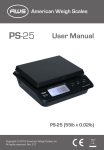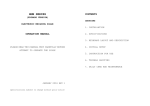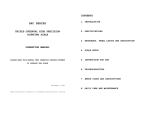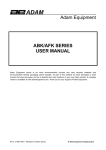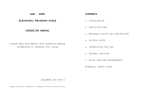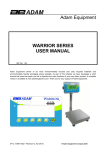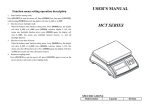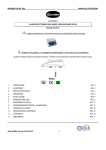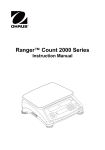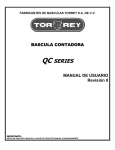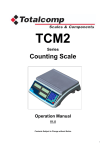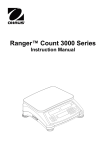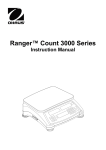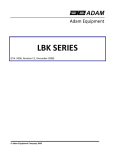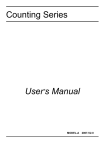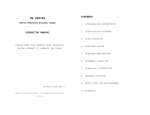Download SHC User Manual
Transcript
SAC / SHC / SHC-CH SERIES HIGH PRECISION COUNTING SCALE OPERATION MANUAL PLEASE READ THIS MANUAL VERY CAREFULLY BEFORE ATTEMPT TO OPERATE THE SCALE July 2008 Rev 1 Specifications subject to change without prior notice CONTENTS 1. INSTALLATION 2. SPECIFICATIONS 2.1 GENERAL SPECIFICATIONS 2.2 MINIMUM PIECES, WEIGHT APPLIED & SAMPLE SIZE WEIGHT SPECIFICATIONS 3. KEYBOARDS, PANEL LAYOUT AND DESCRIPTION 4. SCALE SETUP 5. INSTRUCTION FOR USE 6. TROUBLESHOOTING 7. ERROR CODES AND DESCRIPTIONS 8. DAILY CARE AND MAINTENANCE 1. INSTALLATION CAUTION: a. This is a precision measuring device, handle with extreme care. b. Allow 2 minutes for warm up before operating. 1.1 CHECK and make sure that the following accessories are included: a. This operation manual b. Scale x 1 c. Platter x 1 d. Power adaptor x 1 Contact your dealer if any items are missing. 1.2 INSERT the platter onto the scale carefully. No excessive force is required. 1.3 POWER THE SCALE ON a. Before plugging the power adaptor into an electricity outlet, check and make sure that the input voltage of power adaptor matches with the output voltage of the outlet. If not, do not plug in and contact your dealer immediately. b. Before first time use, plug the main adaptor into the power outlet and charge the scale for at least 8 hours. 1.4 RETAIN the packing materials for future transportation purposes. CAUTION: In some countries, this unit is required by law to be sealed (or stamped) and bearing a serial number. Do not serial break affixed or to remove this the seal scale. (or Such stamp) actions or may offense the law and void the warranty. Contact your dealer for more information or after sales service. For most accurate result, do not use this scale when environment conditions fall beyond those listed in SPECIFICATIONS. Do not attempt to open this unit or conduct any fault finding other than those listed in TROUBLE SHOOTING. 2. SPECIFICATIONS 2.1 GENERAL SPECIFICATIONS Metric Unit Model No. Max1/e1 Max2/e2 Max3/e3 SAC-7.5C 1500g/0.1g 3000g/0.2g 7500g/0.5g SAC-15C 3000g/0.2g 7500g/0.5g 15000g/1g SAC-30C 7500g/0.5g 15000g/1g 30000g/2g SAC-60C 15000g/1g 30000g/2g 60000g/5g Platter Size Power Source Operation Environment 230 x 345mm All Stainless Steel Built-in Rechargeable or Power Adaptor 0o~40oC(32o~104oF), Non-condensed R.H.≤85% Imperial Unit Model No. Max1/e1 Max2/e2 Max3/e3 SAC-7.5C 3lb/ 0.0002lb 7.5lb/ 0.0005lb 15lb/ 0.001lb SAC-15C 5lb/ 0.0005lb 15lb/ 0.001lb 30lb/ 0.002lb SAC-30C 10lb/ 0.001lb 30lb/ 0.002lb 60lb/ 0.005lb SAC-60C 30lb/ 0.002lb 75lb/ 0.005lb 150lb/ 0.01lb Specifications subject to change without notice Metric Unit Model No. Capacity / Readability SHC-1.5C 1500g / 0.05g SHC-3C 3000g / 0.1g SHC-6C 6000g / 0.2g SHC-15C 15kg / 0.5g SHC-30C 30kg / 1g SHC-60C 60kg / 2g Platter Size 230 x 345mm All Stainless Steel or 180 x 292mm for small capacities Power Source Operation Environment Built-in Rechargeable or Power Adaptor 0o~40oC(32o~104oF), Non-condensed R.H.≤85% Imperial Unit Model No. Capacity / Readability SHC-1.5C 3 lb / 0.0001 lb SHC-3C 6 lb / 0.0002 lb SHC-6C 12 lb / 0.0005 lb SHC-15C 24 lb / 0.001 lb SHC-30C 60 lb / 0.002 lb SHC-60C 120 lb / 0.005 lb Specifications subject to change without notice Metric Unit Model No. Capacity / Readability SHC-3CH 3000g / 0.05g SHC-6CH 6000g / 0.1g SHC-12CH 12kg / 0.2g SHC-30CH 30kg / 0.5g SHC-60CH 60kg / 1g Platter Size 230 x 345mm All Stainless Steel or 180 x 292mm for small capacities Power Source Operation Environment Built-in Rechargeable or Power Adaptor 0o~40oC(32o~104oF), Non-condensed R.H.≤85% Imperial Unit Model No. SHC-3CH Capacity / Readability 6 lb / 0.0001 lb SHC-6CH 12 lb / 0.0002 lb SHC-12CH 24 lb / 0.0005 lb SHC-30CH 60 lb / 0.001 lb SHC-60CH 120 lb / 0.002 lb Specifications subject to change without notice 2.2 MINIMUM PIECES, WEIGHT SAMPLE SIZE WEIGHT SPECIFICATIONS APPLIED Metric Unit Model No. Recommended Minimum Piece Weight SAC-7.5C 0.05g Weight Applied 2g Sample Size Weight 2g SAC-15C 0.1g 4g 4g SAC-30C 0.25g 10g 10g SAC-60C 0.5g 20g 20g Imperial Unit Model No. Recommended Minimum Piece Weight SAC-7.5C 0.0001lb Weight Applied 0.004lb Sample Size Weight 0.004lb SAC-15C 0.00025lb 0.01lb 0.01lb SAC-30C 0.0005lb 0.02lb 0.02lb SAC-60C 0.001lb 0.04lb 0.04lb & Specifications subject to change without notice Metric Unit Model No. Recommended Minimum Piece Weight SHC-1.5C 0.025g Weight Applied 1g Sample Size Weight 1g SHC-3C 0.05g 2g 2g SHC-6C 0.1g 4g 4g SHC-15C 0.25g 10g 10g SHC-30C 0.5g 20g 20g SHC-60C 1g 40g 40g Imperial Unit Model No. Recommended Minimum Piece Weight SHC-1.5C 0.00005lb Weight Applied 0.002lb Sample Size Weight 0.002lb SHC-3C 0.0001lb 0.004lb 0.004lb SHC-6C 0.00025lb 0.01lb 0.01lb SHC-15C 0.0005lb 0.02lb 0.02lb SHC-30C 0.001lb 0.04lb 0.04lb SHC-60C 0.0025lb 0.1lb 0.1lb Specifications subject to change without notice Metric Unit Model No. Recommended Minimum Piece Weight SHC-3CH 0.025g Weight Applied 1g Sample Size Weight 1g SHC-6CH 0.05g 2g 2g SHC-12CH 0.1g 4g 4g SHC-30CH 0.25g 10g 10g SHC-60CH 0.5g 20g 20g Imperial Unit Model No. Recommended Minimum Piece Weight SHC-3CH 0.00005lb Weight Applied 0.002lb Sample Size Weight 0.002lb SHC-6CH 0.0001lb 0.004lb 0.004lb SHC-15CH 0.00025lb 0.01lb 0.01lb SHC-30CH 0.0005lb 0.02lb 0.02lb SHC-60CH 0.001lb 0.04lb 0.04lb Specifications subject to change without notice 3. KEYBOARDS & PANEL LAYOUT AND DESCRIPTION KEYS DESCRIPTION 1. ON/ZERO KEY Press this key to turn scale on or set weight to zero. Refer to SPECIFICATIONS for maximum to the weight zero range. 2. TARE KEY Press this key tare off of a container. Refer to SPECIFICATIONS for maximum tare range. 3. NUMERIC AND DECIMAL KEYS Press these keys to attain the desired numeric value. 4. OFF KEY Press this key to turn scale off. 5. CLEAR KEY Press this key to clear the numeric figure entered 6. UNIT PIECE WEIGHT SET KEY Press this key to enter a unit piece weight. 7. NUMBER SET KEY Press this key to enter the number of pieces on platter. 8. CHECK KEY Press this key to set upper weight and quantity check limit. 9. M+ KEY Press this key to add current total count to memory. Note: When the WEIGHT PANEL shows a negative value, the total count will still give a positive count value. The quantity is still added to memory when M+ key is pressed. 10. MR KEY Press this key to recall accumulated results. 11. PLU KEYS Press this key to set/recall a unit piece weight to/from a PLU. INDICATORS DESCRIPTION 12. ZERO INDICATOR When a zero weight is detected, an arrow will appear and point at this indicator. 13. NET WEIGHT INDICATOR When the tare function is in operation, an arrow will appear and point at this indicator. The weight being displayed on the WEIGHT PANEL is a net weight. 14. LO-BAT INDICATOR This indicator turns on when the battery inside scale is low. Recharge the scale immediately. Failure to do so may cause unrecoverable damage to the battery. 15. LOW UNIT WEIGHT INDICATOR An arrow will appear and point at this indicator when the unit piece weight applied/detected is less than the recommended minimum piece weight as listed on 2.2. 16. LOW SAMPLE SIZE INDICATOR An arrow will appear and point at this indicator when the sample size applied/detected is less than the recommended minimum sample size as listed on 2.2. 17. M+ INDICATOR This indicator will appear when memory contains of transaction data. 18. CHARGING INDICATOR This indicator shows battery recharge status. Red color: Battery is being charged Green color: Recharge completed PANELS DESCRIPTION 19. WEIGHT PANEL The current weight detected is shown here. 20. UNIT WEIGHT PANEL The current unit piece weight entered is shown here. 21. TOTAL COUNT PANEL Total count of the current transactions is shown here. 4. SCALE SETUP 4.1 PLACE THE SCALE Place this unit on a hard and strong surface, where is free from RF interference, vibration, fire, airflow, direct sunlight and excessive moisture. For most accurate weighing result, always place this unit on a level surface. If necessary, adjust the adjustable feet underneath the scale to obtain a level condition. 4.2 TURN SCALE ON AND OFF Press ON/ZERO to turn scale on or press OFF to turn scale off. 4.3 BACKLIGHT SETTINGS 4.3.1 Turn backlight on: - Power Saving Mode a. Turn scale on b. Press and hold 1 c. Backlight is turned on NOTE: Under this Power Saving Mode, backlight will automatically turn off after weight displayed is unchanged for about 20 seconds or when a zero weight remains unchanged for about 10 seconds. Backlight will be turned on again by pressing any key or when a new weight is detected. 4.3.2 Turn backlight on: - Without Power Saving Mode a. Turn scale on b. Press and hold 2 c. Backlight is turned on NOTE: Backlight under this mode will remain lit on until manually turned off. 4.3.3 Turn backlight off Press and hold 0 until backlight is turned off 4.4. INTERNAL FUNCTIONS SETTINGS 6 internal functions1 are available. They are: F0 To set motion filter when at zero F1 Check offset value F2 Check display segments F3 Check span value F4 Set auto power off F6 To set motion filter when weighing 4.4.1 How to Enter the Functions Required a. Turn scale on by pressing ON/ZERO, then press and hold NUMBER SET before scale completes counting down b. c. The WEIGHT PANEL shows F1 Press NUMBER SET until the desired function number appears d. Press @WT/SET to enter selection e. Press M+ to save and quit to normal operation status 4.4.2 Set Zero Motion Filter (F0) To ensure the best performance under poor operating environment, this scale can set motion filter when at zero. Follow the below steps to set the motion 1 F1 and F4 are for qualified service personnel only. May be disable as requested by metrological legislation of certain countries. filter. a. b. c. Refer to step a to c in 4.4.1 and select F.0 Press @WT/SET to enter WEIGHT panel shows F0 and UNIT WEIGHT panel shows ZEro_0 d. e. f. Press @WT/SET to select from ZEro_0 to ZEro_4 Press NUMBER SET to confirm Press M+ to restart the scale 4.4.3 Check Display Segments (F2) a. b. Refer to the 4.4.1 on how to enter F2 Press @WT/SET c. All display segments will be lighted up d. Check digits and arrow indications of all 3 panels to verify any defects or errors e. Press CLEAR to quit 4.4.4 Set Auto Power Off Status (F4) This unit is equipped with AUTO POWER OFF function. Default setting = auto off after 4 minutes unused. Follow the below steps to disable/employ the AUTO POWER OFF function. a. Refer to the 4.4.1 on how to enter F4 b. Press @WT/SET to shift between 0_OFF and 4_OFF -To disable the AUTO POWER OFF function, press NUMBER SET when display shows “0-OFF” -To employ the AUTO POWER OFF function, press NUMBER SET when display shows “4-OFF” c. Scale display F6 d. Press M+ to restart the scale 4.4.5 Set Weighing Motion Filter (F6) The weighing motion filter gives a more stable result when the operating environment is in a poor condition. Follow the below steps to set the motion filter. a. b. c. Refer to step a to c in 4.4.1 and select F.6 Press @WT/SET to enter WEIGHT panel shows F6 and UNIT WEIGHT panel shows Filt_0 d. e. f. Press @WT/SET to select from Filt_0 to Filt_4 Press NUMBER SET to confirm Press M+ to restart the scale 5. INSTRUCTIONS FOR USE Before using, allow 2 minutes for warm up. 5.1 ZERO UNLOADED THE WEIGHT DISPLAYED WHEN If ZERO INDICATOR does not appear when the unit is not loaded, press ON/ZERO to set weight displayed to zero. Refer to SPECIFICATIONS for maximum zero range. 5.2 TARE FUNCTION 5.2.1 Actual Tare Method a. Place a container onto the platter b. Press TARE to tare off the weight of this container c. After TARE is pressed, zero weight will be displayed and the NET WEIGHT INDICATOR appears. 5.2.2 Pre Tare Method a. Enter the pre-tare weight value through numeric keys b. c. Press TARE After TARE is pressed, a minus pre-tare weight will be displayed and the NET WEIGHT INDICATOR appears 5.2.3 Clear Weight of a Container from Memory a. Remove all loads from platter b. c. Press TARE NET WEIGHT INDICATOR disappears and weight value resides in memory is now erased 5.3 PLACE A LOAD Always place Shock/excessive a load onto force may the platter cause gently. irrecoverable damage to the weight sensor inside. It is a good practice to remove all loads from platter immediately after weighed. This would prolong the lifetime of the weight sensor. 5.4 WEIGHING APPLICATIONS Before weighing, make sure that the ZERO INDICATOR is on. Should a container is used, refer 5.2 for how to tare off the weight of the container. Place an object on platter and the weight of it is displayed on WEIGHT PANEL. For best weighing result, refer to SPECIFICATIONS for recommended minimum weight to be applied. 5.5 UNIT PIECE WEIGHT2: - THE FOUNDATION OF 2 For best counting result, refer to 2.2 MINIMUM PIECES, WEIGHT APPLIED & SAMPLE SIZE WEIGHT SPECIFICATIONS for recommended minimum piece weight and sample size. COUNTING Unit piece weight can be entered or obtained by either of the following methods: a. By Direct entry method when the unit piece weight is known, or b. By Sampling method when the unit piece weight is not known 5.5.a a. b. Procedures of Direct Entry Method3 Refer to 5.1 and 5.2 for zero and tare Enter the unit piece weight and confirm by pressing @WT/SET. The unit piece weight is now displayed on the UNIT WEIGHT PANEL NOTE: Under ENHANCEMENT this method, FUNCTION will the be AUTO PIECE disabled WEIGHT for same subsequent counting. 5.5.b a. Procedures of Sampling Method Refer to 5.1 and 5.2 for zero and tare b. Place a sample with known quantity on platter c. Enter the quantity of the sample through the numeric keypad and confirm by pressing NUMBER SET d. The scale will automatically determine the unit piece weight. The unit piece weight will then 3 When the individual unit piece weight is not standardized, it is strongly recommended that unit piece weight should be obtained through Sample method as described in 5.5.b. be displayed on the UNIT WEIGHT PANEL e. Sampling process is now completed 5.6 AUTO PIECE WEIGHT ENHANCEMENT FUNCTION In order to obtain the best counting result and to avoid and minimize sampling error, this scale is equipped with AUTO UNIT PIECE WEIGHT ENHANCEMENT FUNCTION. This function will automatically be employed when the unit piece weight is obtained through the sampling method as described in 5.5.b. 5.6.1 How AUTO UNIT PIECE WEIGHT ENHANCEMENT FUNCTION Works After a unit piece weight is obtained by methods as described in 5.5.b, then place more loads onto the platter. The new quantity will be shown on the TOTAL COUNT PANEL. The AUTO will UNIT update PIECE the WEIGHT unit ENHANCEMENT piece weight FUNCTION if both requirements of below are met: a. The quantity added to platter is more than 4 pieces, and b. The quantity added to platter is less than 100% of previous maximum counts previously attained from the same transaction. If the above requirements are met, a new unit piece weight will be displayed on the UNIT WEIGHT PANEL and confirmed by an audio "beep". AUTO UNIT PIECE WEIGHT ENHANCEMENT FUNCTION will be terminated when a zero weight is detected during the transaction process. 5.7. WARNING INDICATORS 5.7.1 LOW UNIT WEIGHT INDICATOR This indicator appears when the unit piece weight is less than the recommended minimum piece weight as listed on 2.2. This means that the unit piece weight is too light to generate accurate counting results. Use another counting scale with a lower e 1 value as listed on 2.1 GENERAL SPECIFICATIONS. Should a counting scale with better resolution is not available. Counting operations may proceed but greater tolerance on counting results has to be allowed. 5.7.2 LOW SAMPLE SIZE INDICATOR This indicator appears when the sample weight applied is less than the recommended minimum sample size weight as listed on 2.2. This means that the sample size is not sufficient to generate accurate counting results. Increase the number of the sample size until this indicator turns off. Should increasing the sample size is not possible. Counting operations may proceed but greater tolerance on counting results has to be allowed. 5.8 COUNTING APPLICATION a. b. Refer to 5.1 and 5.2 for zero and tare Obtain unit piece weight through either methods as listed on 5.5 c. Step by step add more load onto the platter (or remove part of the load from the platter) d. The latest weight, unit piece weight and total quantity would be displayed on the corresponding panel 5.9 MEMORY FUNCTIONS 5.9.1 Accumulated Counting Transaction a. b. Obtain a transaction result through 5.8 Press M+ to save weight and total count to memory c. Scale displays "tOt.01" on the UNIT WEIGHT PANEL, 01 denotes as the first memory entered. The weight and total count of current transaction are saved to memory d. The M+ INDICATOR appears to indicate that memory is now containing data e. Repeat above steps for subsequent counting transactions NOTE 1: If no unit piece weight is applied, only weight data will be saved to memory. 5.9.2 Adding Quantity to Memory Manually Follow the below procedures to add quantity to memory a. Remove all loads from platter b. Make sure that the ZERO INDICATOR appear and the NET INDICATOR disappears c. Enter the desired quantity to be added to memory through numeric keys d. Press M+ e. Quantity is now added to memory 5.9.3 Recall Accumulated Data from Memory a. b. Press MR Scale displays "tOt.#" on the WEIGHT PANEL. # Denotes the total number of entries saved to memory. Then, the total accumulated weight and total count are displayed on the WEIGHT and TOTAL COUNT PANEL respectively c. The scale will return to normal operation 2 seconds after the accumulated data is displayed NOTE: Data stored will be erased when the scale is turned off. 5.9.4 To Clear Accumulated Data from Memory a. Press MR b. Total accumulated data will be displayed on 3 display panels c. Press CLEAR d. All data is cleared now e. The scale will return to normal operation 5.10 CHECK FUNCTIONS This unit is equipped with check functions. When quantity or weight reaches or excesses the preset value, a continuous audio beep and flashing display will be activated. 5.10.1 Set Quantity Check Limit a. b. Press CHECK Scale displays CH.__ on UNIT WEIGHT PANEL c. Enter keys preset quantity value through numeric d. e. f. Value entered is shown on the UNIT WEIGHT PANEL Press NUMBER SET to confirm Scales PANEL displays while CH._PSC the value on the entered UNIT on WEIGHT the TOTAL COUNT PANEL g. Scale return to normal operation within 2 seconds 5.10.2 Set Weight Check Limit a. b. Press CHECK Scale displays CH.__ on UNIT WEIGHT PANEL c. Enter preset weight value through numeric keys d. e. f. Value entered is shown on the UNIT WEIGHT PANEL Press @WT/SET to confirm Scales displays CH._Wt on the UNIT WEIGHT PANEL while the value entered on the WEIGHT PANEL g. Scale return to normal operation within 2 seconds 5.10.3 Clear Quantity Check Limit a. b. c. Press CHECK Press 0 Press NUMBER SET d. Wait until the scale return to normal operation e. The upper memory weight limit is now erased from 5.10.4 Clear Weight Check Limit a. b. c. Press CHECK Press 0 Press @WT/SET d. Wait until the scale return to normal operation e. The upper count limit is now erased from memory 5.11 UNIT PIECE WEIGHT MEMORY (PLU) 5.11.1 Saving a Unit Piece Weight to PLU This scale is equipped with 8 unit piece weight PLU memories. Save a unit piece weight to PLU by either one of the following methods: a. b. By Direct entry method, or By Current unit piece weight method 5.11.a Direct Entry Method a. Key in the unit piece weight through keypad. Make sure the unit piece weight does not exceed 6 figures disregard the decimal place b. Press and hole the preferred PLU location for about 2 seconds until Pr._SET appears c. Data is now stored 5.11.b a. Current Unit Piece Weight Method Obtain a unit piece weight through procedures listed on 5.5.b b. Press and hole the preferred PLU location for about 2 seconds until Pr._SET appears c. Data is now stored NOTE: Data stored in PLU will not be erased when scale is powered off. 5.11.2 Recall Unit Piece Weight from Memory To recall unit piece weight stored in memory, simply press the corresponding PLU. After the PLU is pressed, the unit piece weight will be displayed on the UNIT WEIGHT PANEL. 5.11.3 Clear Unit Piece Weight PLU a. Press 0 b. Press and hold the preferred PLU location to clear c. Wait until the scale displays PRE._SET on UNIT WEIGHT PANEL d. Release PLU e. Memory is cleared and scale returns to normal operation 5.12 COMPUTER (OPTIONAL) DATA RS232C 5.12.1 Connect the Scale with a Computer OUTPUT Follow the below steps to connect the scale with a computer. a. Turn scale off b. Turn computer off c. Connect the RS232C output of scale to computer with an appropriate data cable d. Turn scale on e. Turn computer on f. Load and run the BASICA program file (For DOS platform) 5.12.2 Default Output Settings • BAUD RATE = 9600 • DATA BITS = 8 • PARITY = NONE • STOP BITS = 1 5.12.3 When Using DOS System a. Create BASICA computer program file as below to enable the computer to receive data sent by scale. 10 OPEN "COM*:9600, N,8,1,CS,DS,CD" AS#1 *: Input 1 if the input port of computer is COM 1, or input 2 for COM 2 ...etc. 20 LINE INPUT #1, A$ 30 PRINT A$ 40 GOTO 20 50 END b. Save the above program file. 5.13 PRINTER OUTPUT (OPTION) By pressing the M+ and by erasing the accumulated data (by pressing MR followed by CLEAR), the follow data will be transmitted to printer. S/N WT @WT PCS (NOTE 1) 01. 78 1.0000 78 02. 580 2.0000 290 (NOTE 2) 03. +++ 100 (NOTE 3) 03/ 658 468 (NOTE 4) NOTE 1: S/N = Serial Number, WT = Weight, @WT= Unit Piece Weight, PCS = Total quantity. An underlined heading will be transmitted if M+ is pressed for the first time. NOTE 2: By pressing M+ again, the data of 2nd transaction is transmitted. NOTE 3: +++ means the count number is added to memory by manual entry. NOTE 4: When the total accumulated transaction is erased (by pressing MR followed by CLEAR), the total number of transaction, total accumulated weight and count number are transmitted. A consecutive dot line sent before the accumulated result denotes the total accumulated value. 5.14 RECHARGE THE SCALE When the LO-BAT INDICATOR appears, recharge the scale immediately. Fail to do so will damage the rechargeable battery inside. Recharging is possible during operation. The charge status is indicated by the In-Charge INDICATOR as below: RED: Battery is charging. GREEN: Battery charge completed. 6. TROUBLESHOOTING SyndromeScale cannot be turned on Check: Is the scale charged? Action: Recharge the scale for at least 8 hours before use for the first time or plug in the power adaptor before power on the scale. Check Is the power adaptor plug in properly into both the electricity outlet and the DC inlet of scale? Action: Secure both ends of the power adaptor and try again. Syndrome Scale turned off automatically Check Is the AUTO POWER OFF function enabled? Action Refer to 4.4.3 to disable the AUTO POWER OFF function. Check Is the LO-BAT INDICATOR on? Action Apply the power adaptor. Syndrome Rated capacity cannot be reached Check Is the TARE INDICATOR on? Action: Turn the scale off. Remove all loads from platter and turn on again. Check Is there anything obstructing the platter? Action Remove all obstacles. Syndrome When turning on scale, all display PANEL blank out but only the ZERO and TARE INDICATOR appear Check Is any load applied to platter when turning scale on? Action: Turn scale off. Remove all loads from platter and turn scale on again. Check Is the platter inserted properly? Action: Turn scale off. Insert platter properly and turn scale on again. Syndrome WEIGHT and TOTAL COUNT PANEL blank out during operation Check Does the load applied to platter exceed the rated capacity of scale? Action Remove all loads from platter and try to put less loads. Syndrome Weighing result is not accurate Check Is the scale placed in a level condition? Action Adjust the adjustable feet to a level condition. Check Is the scale affected by airflow, vibration or RFI? Action: Place the scale away from interferences. Check Is the scale calibrated correctly? Action Contact your dealer. all 7. ERROR CODES AND DESCRIPTIONS Err_1: Accumulation error. M+ cannot be activated when weight applied is zero or while the same transaction has already been accumulated. Err_2: EEPROM parameter error. Contact dealer for service. Err_3: Offset value too low. Contact dealer for service. Err_4: Offset value too high. Removed all loads from platter and restart again. Should same error code appear again, contact dealer for service. Err_5: The calibrated weight applied is range. Contact dealer for service. out of 8. DAILY CARE AND MAINTENANCE a. Precision measuring device, handle with extreme care. b. Clean the scale with a soft and damp cloth. If necessary, apply a mild detergent. c. Do not use any harsh, abrasive material, acetone, volatile solvent, thinner or alcohol for cleaning. d. Verify the accuracy of scale periodically. NOTE: In restricted some countries, to be calibration done by is an authorized/qualified agent only. Contact your dealer for more information. e. It is a good practice to apply the dust cover when operating the scale. f. The scale must be placed horizontally during transportation or long time storage. g. Remove platter from scale before transportation or long time storage. h. Store scale in a dry and clean place. X0SAC030000









































